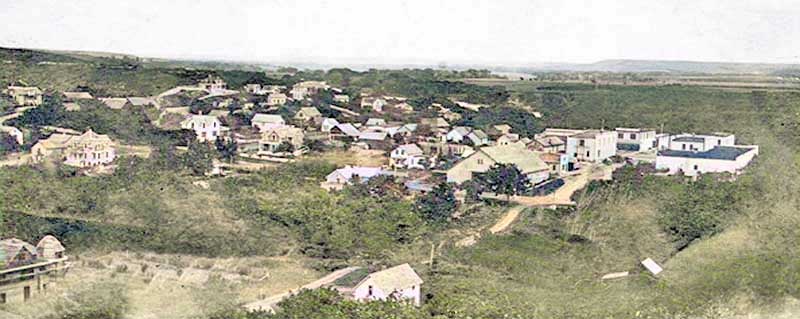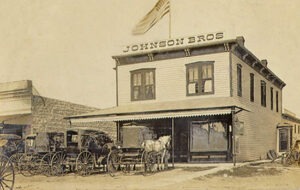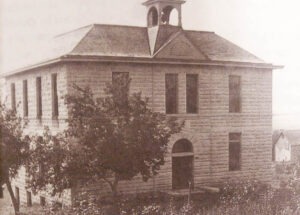Cleburne, Kansas, one of the river towns of Riley County, was located in Swede Township, in the northwest corner of the county. It was razed when Tuttle Creek Dam was built.
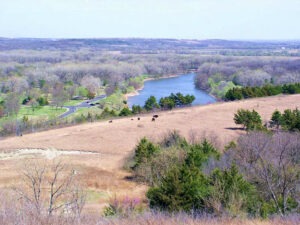
Big Blue River, courtesy Wikipedia.
The township received its name from the creek that flows through it, which was named in honor of Peter Carlson, a Scandinavian who settled on it in 1857. In 1858, L. Pierson settled just below the mouth of Swede Creek, and N. Christenson, a Dane, settled a little farther down the Big Blue River. The same year, the Meyer brothers and Frederic Toburen settled in the township, and later, Mr. Toburen’s parents and his brothers Herman and Adolph.
The town of Big Timber, located on the Big Blue River, was founded in the late 1870s. Swedish men Magnus Vilander, Peter Fernstrom, and John Palmer were Pioneer settlers. In 1877, a German Evangelical Church was erected. At that time, the township had three stone and two frame schoolhouses.
In 1878, it shipped grain and livestock from Irving, nine miles away, on the Central Branch Union Railroad.
A post office was established on December 5, 1878, with Maynus Vilander as postmaster. The settlers initially wanted to name the town after John Vilander, the area’s first landowner, but he refused. At that time, a tri-weekly stage to Manhattan, Randolph, and Irving delivered the mail to the postmaster.
In November 1886, the town’s name was changed from Big Timber to Cleburne for the superintendent of the Blue Valley Railroad, John C. Cleburne, who was coming through the town. The railroad continued along the Blue River to about Blue Rapids.
High school classes were held in a main street store until 1907 when a stone building with a gymnasium and a theater was constructed.
By 1910, the Union Pacific Railroad had taken over the railroad line in Cleburne. At that time, the town boasted a bank, telegraph, and express offices, an international money order office with one rural route, and a population of 225.
Cleburne remained a small town in the following decades. Beginning in the late 1930s, during the Great Depression, the federal government proposed building flood control dams along tributaries of major rivers in Kansas. The Flood Control Act of 1938 authorized the construction of Tuttle Creek Reservoir, which would inundate Cleburne. Though action on building the dam was slow, after a series of floods and the massive 1951 flood, the Army Corps of Engineers began building the dam. Though several communities, including Cleburne, fought back with a “Big Dam Foolishness” campaign, they could not stop the dam’s construction.
Construction of the Tuttle Creek dam began in 1952. In the next years, the dam displaced 3,000 people and ten towns, including Stockdale, Cleburne, Garrison Crossing, Randolph in Riley County. However, Randolph relocated and still exists today.
The railroad in Cleburne was abandoned in 1958 due to the Tuttle Creek project, and the Cleburne post office closed on July 31, 1960. That year, the town was razed.
The dam became fully operational by July 1962.
Afterward, the Cleburne townsite was turned into a park. Today, however, the park has been abandoned and is badly deteriorated.
The remains of the old town, including a network of old roads, concrete sidewalks, foundations, and debris, can still be seen at the side. The lake is now at least a quarter-mile away from the old town.
The townsite, located on Corps land, can be reached by taking Swede Creek Road east from U.S. Highway 77 about five miles to Bellegarde Road, then one mile east to Cleburne Park Road, then about two miles south.
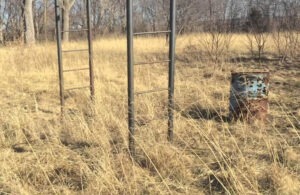
Cleburne, Kansas today, courtesy YouTube.
©Kathy Alexander/Legends of Kansas, updated November 2024.
Also See:
Sources:
Blackmar, Frank W.; Kansas: A Cyclopedia of State History, Vol I; Standard Publishing Company, Chicago, IL 1912.
Cutler, William G; History of Kansas; A. T. Andreas, Chicago, IL, 1883.
McKeon, Kevin, and Goerl, Katie; Kansas Swedish Settlement Belt, Chapman Center Research Collections, 2016.
YouTube

